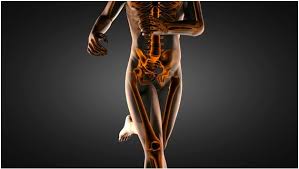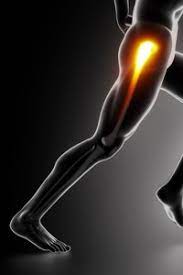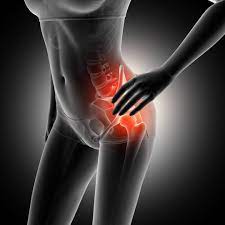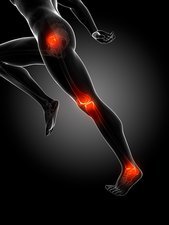

Forward head posture (FHP) might start at the neck, but its ripple effect can travel all the way down to your hips like a bad email chain nobody asked for.
Most of us are guilty of becoming modern-day human question marks—craning our necks forward to stare at screens or scroll endlessly through our phones.
But what seems like an innocent tilt of the head can mess with your entire kinetic chain.
Here’s how: When your head shifts forward, the body has to adapt to keep you upright.
Your upper back rounds, shoulders slump (giving rise to mom’s shoulders), and your center of gravity shifts forward.
To compensate, your pelvis tilts, and your hip flexors go into overdrive trying to stabilize the imbalance. This results in tight hips, altered gait, and imbalance in your lower legs.
It is like your hips are picking up the slack for your neck’s bad habits.
Real-life example? Think of office workers glued to their laptops or teens hunched over game consoles.
Studies from the Journal of Orthopaedic & Sports Physical Therapy show that FHP significantly alters pelvic alignment and increases mechanical stress on the hip joints.
Over time, this can contribute to conditions like hip bursitis, tight iliopsoas muscles, or anterior pelvic tilt.
In short, your head’s drama becomes your hips’ trauma.
- Understanding Forward Head Posture
- The Biomechanics of Forward Head Posture and Its Chain Reaction
- How Forward Head Posture Affects the Pelvis
- Increased Hip Joint Stress: Types and Mechanisms
- The Role of Muscle Imbalances and Compensations
- Scientific Evidence Linking Forward Head Posture to Hip Joint Stress
- Real-Life Examples: Practical Implications
- Conclusion: Addressing the Problem
Understanding Hunch Back Posture
Forward head posture refers to the anterior displacement of the head relative to the shoulders.
It is characterized by a rounded upper back, protruding neck, and increased cervical spine curvature.
This posture is often the result of poor ergonomics, prolonged sitting, and lack of physical activity.
According to a study published in the Journal of Physical Therapy Science (2013), FHP is associated with musculoskeletal dysfunctions and altered spinal alignment, which can lead to compensatory changes in other parts of the body.
The Biomechanics of Forward Head Posture and Its Chain Reaction
The human body operates as a kinetic chain, where the alignment and movement of one joint affect the others.
When the head shifts forward, it alters the body’s center of gravity, requiring compensatory adjustments in the spine, pelvis, and lower extremities.
How It Works?
- Forward head posture increases the load on the cervical spine, as every inch of forward displacement adds approximately 10 pounds of additional force.
- To maintain balance, the thoracic spine rounds, and the pelvis tilts anteriorly.
- This anterior pelvic tilt changes the alignment of the hip joint, increasing compressive and shear forces.
This chain reaction demonstrates how FHP can indirectly stress the hip joints by disrupting the body’s natural alignment.
How Forward Head Posture Affects the Pelvis?
Forward head posture (FHP) may seem like a neck issue, but it is actually a full-body plot twist—your pelvis and hips included.
One of the lesser-known but critical relationships in postural dysfunction is between your head and your hips, with the pelvis playing the middleman.
Enter: anterior pelvic tilt (APT), the sneaky sidekick of FHP.
When your head juts forward, your upper spine compensates by curving more.
To rebalance, your lower back arches excessively, tilting your pelvis forward like it is trying to look down too.
This APT causes the hip flexors (like the iliopsoas) to become tight and overactive, while the glutes and hamstrings—your hip extensors—get weaker and lazier than a cat in a sunbeam.
This muscle imbalance creates a cascade of issues:
Increased pressure on the front (anterior) hip capsule, which can lead to hip impingement or bursitis.
A reduced range of motion in the hips, especially during exercises like lunges or deep squats.
Uneven weight distribution when walking or standing, forcing the hips to overcompensate and potentially triggering pain in the lower back, knees, or even the feet.
Take Priya, a graphic designer who spends 10 hours a day at her desk.
She starts noticing that squats hurt her hips and yoga poses like pigeon feel awkward.
Her physio points out a classic FHP-APT combo.
Scientific studies back this link. Research in Clinical Biomechanics has shown that changes in spinal alignment due to FHP can alter pelvic tilt and increase hip joint stress.
Increased Hip Joint Stress: Types and Mechanisms
A quick look at these in brief:
Compressive Stress:
An anterior pelvic tilt, often linked to FHP, causes the femoral head (the ball of the hip joint) to press excessively against the acetabulum (the socket).
This increased compression limits the hip joint’s ability to move freely and absorb shock efficiently.
Over time, the heightened pressure can accelerate cartilage wear, contributing to degenerative conditions like osteoarthritis. Individuals experiencing compressive stress often report stiffness or discomfort, especially during weight-bearing activities like standing or walking.
Shear Stress:
FHP disrupts natural gait mechanics, leading to abnormal movement patterns in the hips.
These changes introduce shearing forces, where the femoral head moves unnaturally within the socket, straining the joint surfaces.
Persistent shear stress can result in labral tears, cartilage damage, or joint instability. Symptoms may include sharp pain or clicking sensations during activities like walking, running, or climbing stairs.
Torsional Stress:
Compensatory movements related to FHP often force excessive internal or external rotation of the hips. This leads to torsional stress, which strains the hip joint and surrounding ligaments.
Over time, this stress can compromise joint stability and increase the risk of ligament injuries. This is particularly problematic in activities that involve repetitive rotation or pivoting motions.
Example: The Runner’s Struggle:
A runner with FHP might experience hip pain due to repetitive shear and torsional forces during their stride.
Poor alignment forces the hips to compensate, creating a biomechanical cascade that overstresses the joint.
Over time, this imbalance can lead to chronic hip pain or even structural damage, highlighting the importance of addressing posture in athletic activities.
The Role of Muscle Imbalances and Compensations
Forward head posture (FHP) doesn’t exist in isolation; it sets off a cascade of muscle imbalances that place additional stress on the hip joints.
These imbalances disrupt the body’s natural alignment and biomechanics, leading to increased strain on key muscle groups and compromised joint health.
Tight hip flexors are one of the most common issues associated with FHP. The iliopsoas and rectus femoris muscles become overactive, pulling the pelvis into an anterior tilt. This forward rotation of the pelvis misaligns the hip joints, increasing pressure on the anterior portion of the joint and limiting efficient movement.
Weak glutes and core muscles are another consequence of FHP. These critical stabilizers lose their effectiveness, forcing the hip joints to absorb greater impact and shocks during movement.
Without proper support, the hips endure excessive strain, making them more susceptible to overuse injuries. Your thigh muscle imbalance is owing to text neck posture and it needs immediate attention.
Hamstring strain also plays a significant role. The anterior pelvic tilt overstretches the hamstrings, reducing their ability to stabilize the hips effectively.
This creates additional stress on the joints, especially during activities like walking, running, or climbing stairs.
Real-life implication: Consider a desk worker with FHP who begins exercising without addressing these imbalances.
When performing squats or lunges, the misaligned pelvis forces the hips to compensate unnaturally, intensifying joint stress.
Over time, this can lead to chronic hip pain or injuries such as muscle strains or cartilage damage. Addressing these imbalances is critical for reducing joint stress and preventing complications.
Scientific Evidence Linking Forward Head Posture to Hip Joint Stress
Numerous studies highlight the connection between postural deviations like FHP and hip joint stress:
- A study in the Spine Journal (2005) showed that postural misalignment increases stress on the lower body, particularly the pelvis and hips, as compensatory mechanisms come into play.
- Research published in Gait & Posture (2017) found that individuals with FHP displayed altered walking patterns, including reduced hip extension and increased shear forces.
- The Journal of Orthopaedic & Sports Physical Therapy (2012) emphasized the role of pelvic alignment in distributing forces through the hip joint, noting that APT significantly increases compressive forces.
These studies underscore the indirect yet profound impact of FHP on hip joint health.
Real-Life Examples: Practical Implications:
We shall share 3 such cases in brief:
Example 1: The Office Worker
Samantha, a 30-year-old graphic designer, spends long hours hunched over her desk. Over time, she developed FHP and noticed persistent hip discomfort.
A physical therapist identified an anterior pelvic tilt, tight hip flexors, and weak glutes as contributing factors.
Her forward head was owing to workplace stress.
Samantha’s FHP caused her hip joints to bear more stress, particularly during standing and walking.
Example 2: The Athlete
Jake, a 25-year-old runner, ignored his FHP until he began experiencing hip pain during long runs.
A self postural assessment revealed compensatory gait mechanics, where his hips rotated excessively to counterbalance his forward head position.
The resulting torsional and shear stresses led to inflammation in his hip joint.
After making adjustments to his posture, Jake noticed a significant improvement in both his running efficiency and hip pain.
Example 3: The Senior Citizen
Linda, a 65-year-old retiree, developed FHP due to years of poor posture and a sedentary lifestyle. She began experiencing hip pain during daily activities like climbing stairs.
Her doctor explained that her FHP and anterior pelvic tilt were increasing compressive stress on her hip joints, worsening her arthritis symptoms.
Addressing her posture through physical therapy reduced her hip discomfort and improved her mobility.
Takeaway
Forward head posture is more than just a neck or upper back issue—it sets off a chain reaction that can significantly impact the hip joints.
By altering pelvic alignment, increasing muscle imbalances, and creating compensatory movement patterns, FHP contributes to compressive, shear, and torsional stresses on the hip joint.
Understanding this connection is essential for addressing the root cause of hip pain and preventing further damage.
While solutions such as postural correction exercises (such as thoracic extensions on a bench), ergonomic changes, and targeted strengthening exist, the key takeaway is recognizing the importance of early intervention to minimize the long-term impact of forward head posture on hip joint health.
References:


